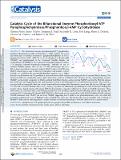Catalytic cycle of the bifunctional enzyme phosphoribosyl-ATP pyrophosphohydrolase/phosphoribosyl-AMP cyclohydrolase
Abstract
The bifunctional enzyme phosphoribosyl-ATP pyrophosphohydrolase/phosphoribosyl-AMP cyclohydrolase (HisIE) catalyzes the second and third steps of histidine biosynthesis: pyrophosphohydrolysis of N1-(5-phospho-β-D-ribosyl)-ATP (PRATP) to N1-(5-phospho-β-D-ribosyl)-AMP (PRAMP) and pyrophosphate in the C-terminal HisE-like domain, and cyclohydrolysis of PRAMP to N-(5′-phospho-D-ribosylformimino)-5-amino-1-(5″-phospho-D-ribosyl)-4-imidazolecarboxamide (ProFAR) in the N-terminal HisI-like domain. Here we use UV–VIS spectroscopy and LC–MS to show Acinetobacter baumannii putative HisIE produces ProFAR from PRATP. Employing an assay to detect pyrophosphate and another to detect ProFAR, we established the pyrophosphohydrolase reaction rate is higher than the overall reaction rate. We produced a truncated version of the enzyme-containing only the C-terminal (HisE) domain. This truncated HisIE was catalytically active, which allowed the synthesis of PRAMP, the substrate for the cyclohydrolysis reaction. PRAMP was kinetically competent for HisIE-catalyzed ProFAR production, demonstrating PRAMP can bind the HisI-like domain from bulk water, and suggesting that the cyclohydrolase reaction is rate-limiting for the overall bifunctional enzyme. The overall kcat increased with increasing pH, while the solvent deuterium kinetic isotope effect decreased at more basic pH but was still large at pH 7.5. The lack of solvent viscosity effects on kcat and kcat/KM ruled out diffusional steps limiting the rates of substrate binding and product release. Rapid kinetics with excess PRATP demonstrated a lag time followed by a burst in ProFAR formation. These observations are consistent with a rate-limiting unimolecular step involving a proton transfer following adenine ring opening. We synthesized N1-(5-phospho-β-D-ribosyl)-ADP (PRADP), which could not be processed by HisIE. PRADP inhibited HisIE-catalyzed ProFAR formation from PRATP but not from PRAMP, suggesting that it binds to the phosphohydrolase active site while still permitting unobstructed access of PRAMP to the cyclohydrolase active site. The kinetics data are incompatible with a build-up of PRAMP in bulk solvent, indicating HisIE catalysis involves preferential channeling of PRAMP, albeit not via a protein tunnel.
Citation
Fisher , G , Pecaver , E , Read , B , Leese , S , Laing , E , Dickson , A , Melo Czekster , C & da Silva , R G 2023 , ' Catalytic cycle of the bifunctional enzyme phosphoribosyl-ATP pyrophosphohydrolase/phosphoribosyl-AMP cyclohydrolase ' , ACS Catalysis , vol. 13 , no. 11 , pp. 7669-7679 . https://doi.org/10.1021/acscatal.3c01111
Publication
ACS Catalysis
Status
Peer reviewed
ISSN
2155-5435Type
Journal article
Description
Funding: This study was supported by the Biotechnology and Biological Sciences Research Council (BBSRC) (Grant BB/M010996/1) via EASTBIO Doctoral Training Partnership studentships to G.F. and B.J.R., and by the University of St Andrews via a StARIS summer research bursary to S.K.L.Collections
Items in the St Andrews Research Repository are protected by copyright, with all rights reserved, unless otherwise indicated.

